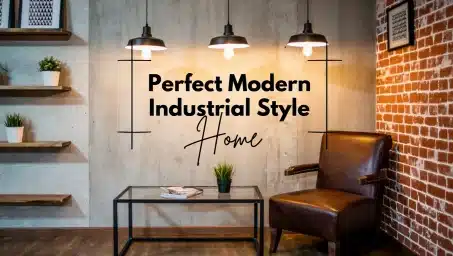There’s something almost magical about a modern industrial style home. It’s that blend of raw and refined, where steel meets sunlight and concrete sits quietly beside lush greenery. This style doesn’t just exist in old warehouses anymore. It’s moved into our neighborhoods, our apartments, even our tiny houses. And when done right, it feels less like a “theme” and more like a whole way of living.
The trick is… you can’t fake it. Modern industrial isn’t about sticking a rusty pipe on the wall and calling it a day. It’s about balance. Comfort. Texture. Even a bit of surprise. You’ve gotta nail certain features if you want the space to feel intentional rather than “unfinished.” And trust me, there are a few that make or break the look.
1. Exposed Structural Elements
If you’ve ever walked into a space and instantly noticed the thick wooden beams overhead or a row of steel columns, you’ve seen the heart of industrial design. These elements aren’t just decoration — they’re part of the building’s bones. The beauty here is that nothing’s pretending to be something else. A pipe is a pipe. A brick is a brick.
It’s tempting to cover these things up with drywall or paint. Don’t. That raw honesty is the charm. Even if you live in a newer home, you can bring this in with faux beams, exposed conduit for lighting, or brick veneer walls. Just remember: if you’re going for “industrial,” you want the structure to whisper, “I’ve been here a long time.”
2. Large, Metal-Framed Windows
Light changes everything in industrial interiors. Those huge, black steel-framed windows you see in old factory buildings? They’re more than just pretty — they make the entire space feel open and alive. The grid pattern adds just enough detail without being fussy.
You don’t have to live in a loft to get the look. Plenty of companies make modern metal-frame windows now, or you can even mimic the effect with window film and thin black trim. The key is letting the glass do the talking. Don’t weigh it down with heavy curtains. If you must have privacy, go for sheer linen panels or simple roller blinds that vanish when you don’t need them.
3. Neutral, Earthy Color Palettes
Modern industrial doesn’t do neon pink walls or candy-colored cabinets. It lives in a moodier, grounded world. Think charcoal grays, warm browns, deep blacks, soft taupes. Sometimes a muted green or navy sneaks in, but it’s never shouting for attention.
The beauty of this palette is how timeless it feels. You can layer textures — brick, metal, wood — without them fighting for attention. And when you do want a pop of color, maybe in a throw pillow or piece of art, it feels deliberate instead of chaotic. The walls, floors, and ceilings all work like a calm stage for everything else to happen.
4. Open-Plan Layouts
There’s something freeing about a big, open space. Modern industrial style leans into this hard, drawing inspiration from old warehouses where walls were rare. Kitchens flow into living rooms. Dining areas are part of the same space as workspaces. It’s about connection, not compartmentalization.
If your home isn’t already open-plan, you can fake it by removing non-load-bearing walls or using wide, open archways instead of doors. Even using the same flooring across multiple rooms can help blur the boundaries. This also means you have to think about the whole space as one story, not a bunch of disconnected chapters.
5. Raw, Honest Materials
If you’ve ever run your hand along a slab of reclaimed wood or brushed your fingers over a cold steel railing, you know what I mean. The tactile quality of industrial materials is what gives them so much personality. Reclaimed wood has scratches, dents, stains — it’s been somewhere. Concrete floors tell stories through their tiny imperfections.
This is not the style for shiny, flawless surfaces. Embrace the little marks and scratches. If you can source reclaimed brick, weathered metal, or salvaged timber, even better. The mix of textures keeps things from feeling too clean or cold. A modern industrial home should feel like it’s lived through something.
6. Statement Lighting
You can’t ignore lighting in industrial design. Those big, bold fixtures — often in matte black or brushed steel — are like jewelry for the room. Oversized pendant lights over the kitchen island. Adjustable wall-mounted lamps in the bedroom. Maybe even an old factory light salvaged from somewhere interesting.
Lighting here isn’t just functional. It’s sculptural. Look for fixtures with exposed bulbs, cage designs, or long swinging arms. Even better if they’ve got some patina. A mix of task lighting and mood lighting means you can go from “bright workspace” to “moody dinner” without changing a single bulb.
7. Minimal but Impactful Furniture
Modern industrial furniture has this knack for being both sturdy and graceful. A chunky wooden table on slim steel legs. A leather sofa that feels like it could outlive you. Pieces tend to be simple in form but rich in material.
You don’t need to crowd the space with furniture either. Let each piece breathe. Because the style tends toward bigger, bolder shapes, too much can make a room feel heavy. And if you can find furniture that looks like it could double as workbenches or storage crates in another life — perfect.
8. Layered Textures
Here’s where industrial spaces really come alive. You might have a cold concrete floor, but it’s softened by a thick wool rug. The steel shelving holds stacks of worn books and soft, crumpled linen throws. Glass sits next to wood. Brick leans against velvet.
The secret is in the contrast. Too much hard material can make things feel harsh, almost unfriendly. Too much softness, and you lose the edge. Keep layering until you’ve got a mix that feels good under your hand and easy on your eyes.
9. Functional, Visible Storage
Industrial style doesn’t hide everything away. In fact, it celebrates storage that’s right out in the open. Wall-mounted shelves with visible brackets. Metal lockers instead of hidden cupboards. Rolling carts that serve as both storage and side tables.
This makes it easier to keep the space organized — everything has its place — but also gives the home a lived-in vibe. The trick is to keep it tidy enough that it feels intentional, not messy. Open storage can be a nightmare if you don’t edit what’s on display.
10. Greenery That Softens the Edge
Plants are the secret ingredient in a lot of industrial spaces, even if people don’t talk about it much. All that metal and concrete can feel cold without something alive in the mix. Big leafy plants in simple pots. Hanging greenery spilling from high shelves. Even a tiny cactus on the coffee table helps.
They don’t just add color. They break up all the straight lines with organic shapes. And they remind you — even in a home full of industrial details — that nature still belongs here.
A modern industrial home isn’t about copying a Pinterest photo down to the last detail. It’s about understanding why the style works and making those principles fit your own life. Maybe you can’t have giant steel windows, but you can use black trim to mimic them. Maybe your apartment doesn’t have exposed brick, but you can bring in reclaimed wood and raw metal accents.
The point is to create a space that feels open, grounded, and full of character. One where the materials tell a story, the light feels intentional, and every scratch or dent just makes it better. When you’ve nailed those ten features, you’re not just living in a modern industrial style home — you’re living in a place that feels like it’s truly yours.

Dorothy is a design lover on a mission to make every space feel inspired — from cozy living rooms to stylish home offices. With a flair for blending comfort, creativity, and practical ideas, she shares decor tips that breathe life into homes, workspaces, and everything in between. Whether you’re revamping a bedroom or refreshing your office nook, Dorothy’s thoughtful ideas help you design spaces that reflect your unique style.
